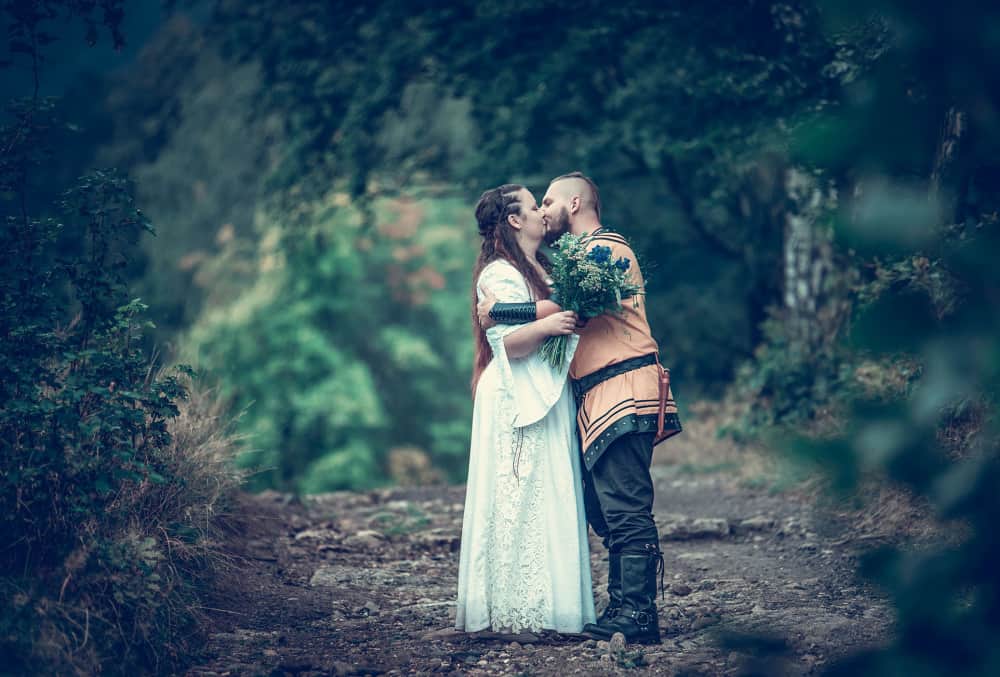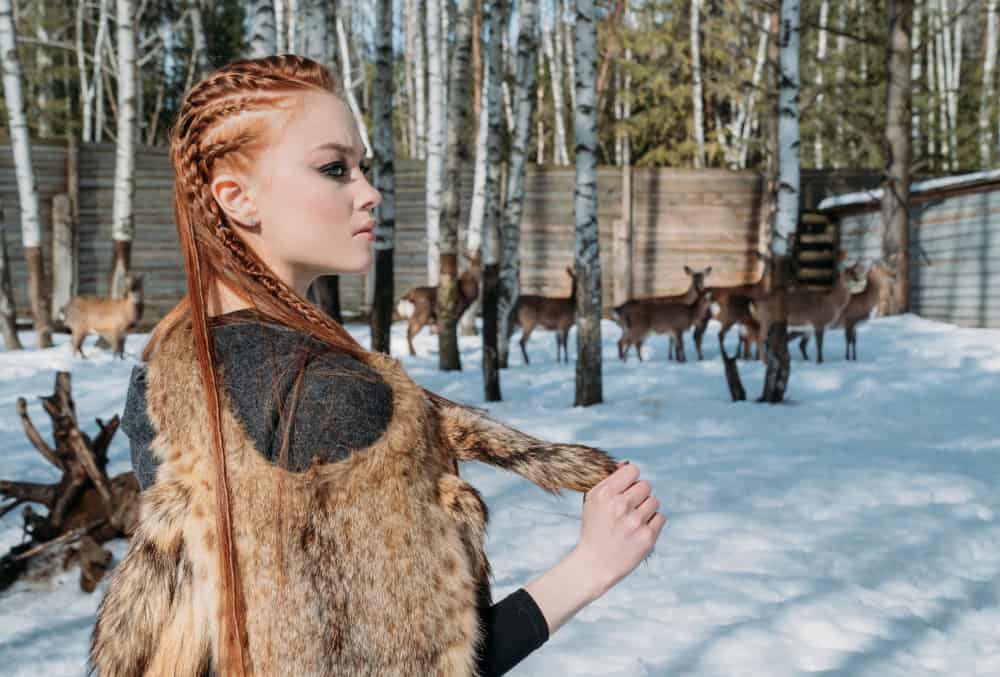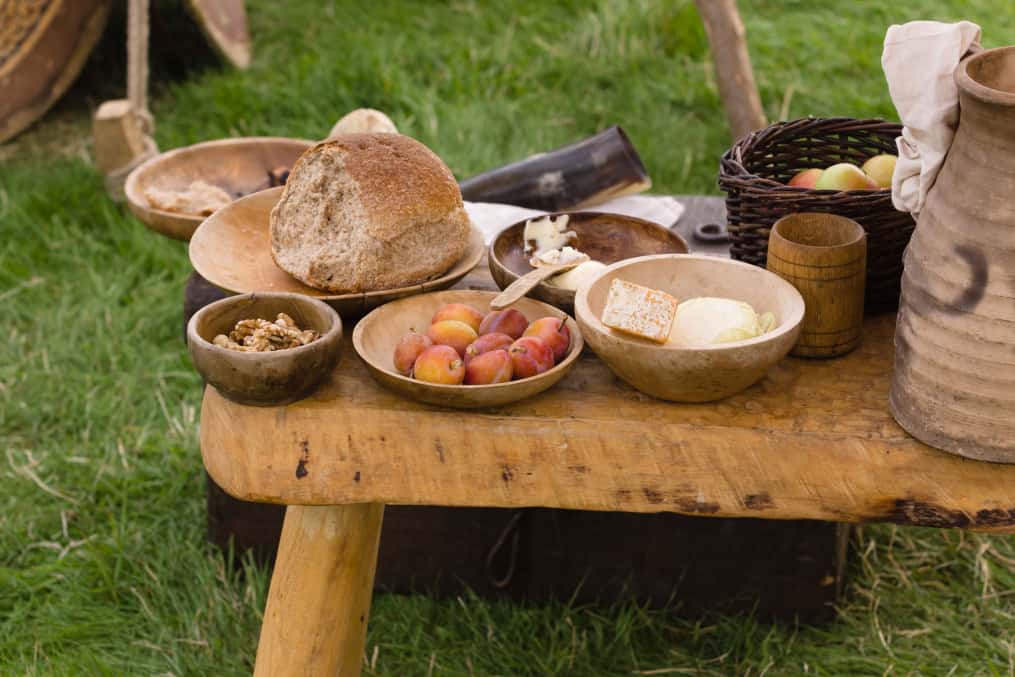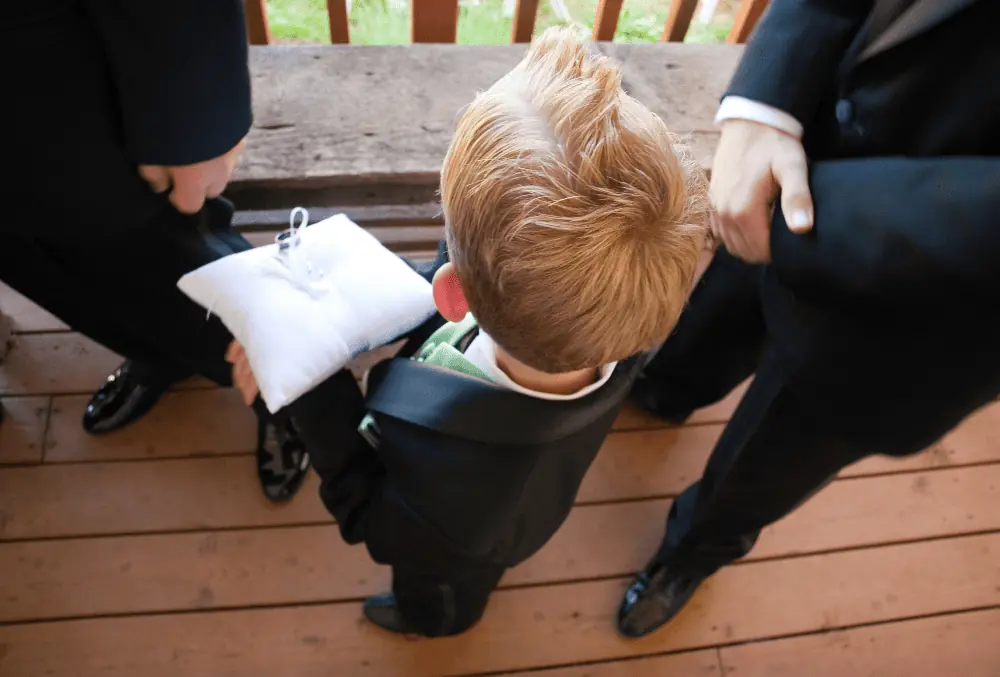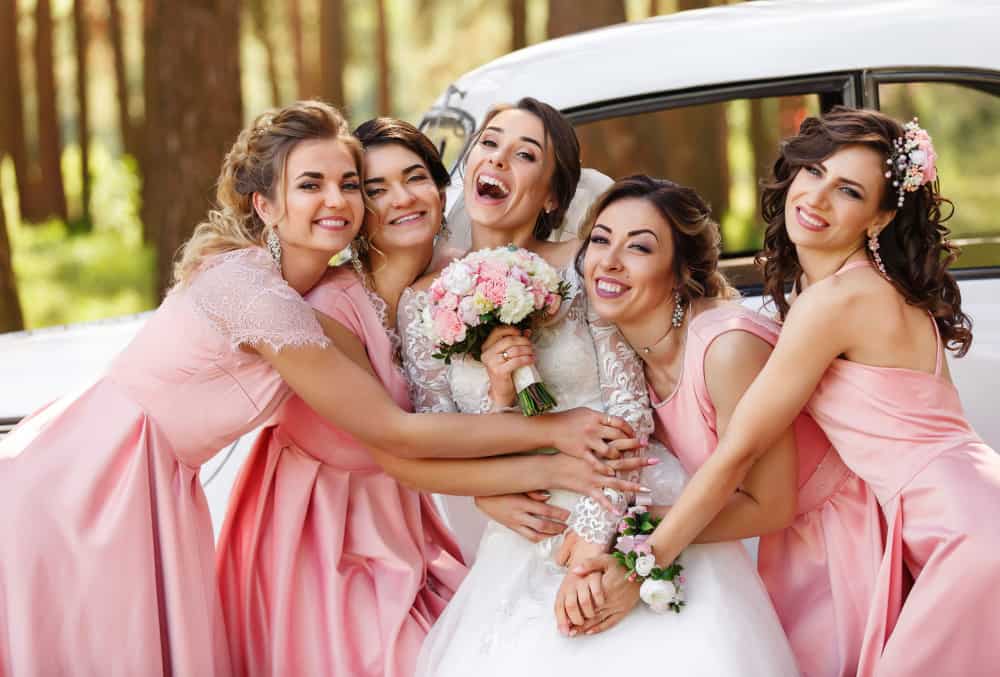Even though the days of the Vikings are long gone, they are still idealized in modern times. Besides the plunder and pillage of gods like Odin and Thor, the Viking society was full of rituals and traditions, including Viking wedding traditions.
In this article, we look at Viking wedding traditions, from the most famous ones to the most bizarre, if not fascinating, wedding traditions.
Viking wedding traditions
Viking wedding traditions involved certain practical acts that had a symbolic value in the eyes of the practitioners and their families. Some of the most common ones were:
- Freya’s Day
- Sword Retrieval Ceremony
- Bathhouse Maidenhood Ritual
- Viking attire – such as cloak, jewelry, belt, tunic, and bridal crown.
- Animal sacrifice for fertility gods Thor, Freyja, and Freyr.
- Viking Wedding Sword Exchange
- “Troth-plight” or the Handfasting Ceremony
- Bride-running (bruð-hlaup or brúðgumareið)
- Mead Drinking
- Accompaniment of 6 Witnesses to the couple’s bed
- The morning after gift
Viking Weddings were held on Fridays and lasted a week.
Traditional Viking weddings took place on Fridays, known as Frigga’s or Freya’s Day. Freya was the goddess of love, marriage, and fertility; it was pictured good luck to get married on Friday.
The Viking wedding rituals also dictated that ceremonies be held at certain times of the year, preferably at the end of the harvest or before heavy snowfall, to avoid food scarcity during weddings.
Viking weddings mostly lasted a week, meaning an ample supply of food and enough drinks was necessary. Winter weddings weren’t possible as the snow rendered movement almost impractical.
Symbolic Sword Ceremony Retrieval for the Grooms
Like Viking brides, the grooms also underwent certain symbolic rituals before entering new lives as married men. Viking grooms had to participate in a symbolic sword ceremony to quit bachelorhood.
In this ceremony, those to accompany him included his father, married friends, and married brothers. The groom-to-be would have to break into a grave to retrieve an “ancestral” sword.
Once the groom retrieved the sword, just like his bride, he was supposed to visit the bathhouse where he’d symbolically cleanse his bachelor status while receiving instructions on fatherly duties.
The Bathhouse Maidenhood Viking Ritual
Before the wedding ceremony, married female friends, alongside family, would escort the bride for cleansing at a bathhouse. Cleansing symbolically meant the bride washed away her maidenhood status.
Viking women set to get married also wore a kransen or a circlet on their heads, symbolizing virginity. However, this was done away with during the bathhouse ritual representing the transition to womanhood.
The kransen, a symbol of virginity, would then be stored away for the bride’s future daughter. It was during the wedding ceremony that the bridal crown replaced the kransen.
The bathhouse had several hot stones placed in the tub to give out steam, and once the bath was over, the bride dived into cold water to close the open pores. That was the end of the cleansing process.
Like the bride, the groom also visited the bathhouse the next day after his wife-to-be had done. He’d also symbolically wash away his bachelor status there while purifying himself for the ceremony.
Traditional Viking Wedding Attire
Traditional Viking weddings were known for their unique and beautiful clothing. In the following section, we’ll look at conventional Viking wedding clothing for the bride and the groom.
The Bride and Groom’s Attire
Traditionally, Viking brides didn’t wear white for their wedding ceremonies but mostly flowy dresses with different patterns and colors, primarily due to the region’s cooler temperatures.
Couples would typically put on several layers of clothing in addition to fur-lined coats. Most importantly, the groom would bear his sword, one of his most critical attire pieces.
Usually, the bride would wear a traditional Viking wedding dress made of wool or linen. As noted earlier, the dress was adorned with embroidery, beads, and intricate designs.
On the other hand, the groom would put on trousers and a tunic, mostly made of linen or wool, alongside a symbolic axe or sword symbolic of his protection and strength.
In short, traditional Viking attire during their weddings included the following:
- Traditional wedding dress
- Tunic and trousers
- A belt
- Cloak or Fur
- Jewelry
Unique Bridal Hairstyles
In Viking culture, a woman’s hair was significant and an indication of her sexual allure, with longer hair considered more appealing. The hair was more important than the dress itself.
Loose and flowing hair alongside intricate braids symbolized a bride’s sexuality. Women would collect flowers, wood, straw, and other materials during weddings to create the bridal crown.
Viking Wedding Ceremonies
Once the premarital rituals were complete, the wedding ceremony could now begin. Remember that these ceremonies lasted for a week, beginning by seeking the attention of gods and goddesses.
Viking Wedding Ceremonies At Times Began with an Animal Sacrifice
Most Viking wedding ceremonies often began with an animal sacrifice. If it was necessary to sacrifice an animal, the most common animals included goats, sows, boars, and, interestingly, even horses.
The Vikings went for the above animals linked with the fertility gods (Thor, Freyja, and Freyr). For Freyr, it was a boar or a horse. For Freyja, it was a sow. For Thor, it was a goat.
The Vikings collected the animal’s fresh blood in a bowl and put it on an altar. After that, they dipped fir twigs in the blood and sprinkled it on the couple to reassure the blessings of the gods.
Priests were the only people who conducted Viking wedding ceremonies. The wedding ceremony’s first part was invoking the gods through the Blot or animal sacrifice ritual.
Viking Couples Swapped/Exchanged Swords and Rings
Next, after the animal sacrifice (if necessary), the groom would give the ancestral sword to his new bride, which she was supposed to keep safe for any future sons they might have together.
The bride would also do the same and present the groom with a sword or blade from her ancestors. This exchange symbolized the transfer of the bride to her newly married husband.
The blade or sword exchange symbolized a sacred union between the couples and their families, and mystic rituals sanctified it. Besides, the couples also exchanged wedding rings and their vows.
The bride received her ring but on the hilt of her groom’s new sword. The groom also received the ring in the same manner, and with the rings upon their hands, it was time for the couples to exchange Viking wedding vows.
“Troth-plight” or the Handfasting Ceremony – Viking wedding vows session
This is another significant Viking wedding tradition, with the most unique thing here being the “troth-plight,” loosely known as the handfasting ceremony or ritual.
In the handfasting ceremony, the bride and the groom had their hands tied together with loose cords or ropes as they uttered their Viking wedding vows.
The Wedding Feast
The wedding feast ceremony comprised of “bride running” and the main banquet — mainly drinking of Mead.
Bride-running (bruð-hlaup or brúðgumareið)
Once the ceremony ended, the priest declared time for brud-hlaup / brúðgumareið or “bride-running” to open the festivities officially. Here, the newlyweds’ families competed with each other to the feast.
Based on tradition, the losing side would serve drinks (honey Mead and beer) to the winning family. But before the wedding feast could begin, the bride and groom had to undertake an obligatory toast to the gods.
The Feast/Mead Drinking
The feasting at Viking traditional weddings began with Mead drinking. The drink was especially essential for the newlyweds. During the feasting ceremony, Mead flowed almost freely.
Since a most Viking weddings were arranged, meaning that the bride and the groom were certainly strangers, Mead helped them begin a conversion alongside other activities.
Besides Mead, when it comes to feasting, the Vikings did it splendorous, as there were diverse foods to sample. The following are traditional Viking wedding foods:
- Mead – Mead was the Vikings’ favorite drink made of fermented honey and a staple in their wedding traditions. The Vikings served it in animal horns, symbolizing happiness.
- Bread – You couldn’t miss finding bread in the Viking society. More of a staple and made of rye, wheat, or barley, it was mainly served at Viking wedding feasts.
- Roasted Meat – Undoubtedly, roasted meat was necessary at all Viking wedding feasts. Vikings served roasted that included pork, lamb, and beef.
- Fish – Known for their prowess at sea, the Vikings had broad access to seafood that included fish, shrimp, crab, and lobster, to mention a few.
- Cheese – Cheese was also a common type of delicacy for the Vikings. Made from goats, cows, or sheep’s milk, the Vikings consumed cheese as a snack during their weddings.
- Vegetables and Fruits – The Vikings also had easy access to various fruits and vegetables, such as plums, berries, apples, onions, and carrots, which were consumed during weddings.
The Wedding Night: At Least 6 Witnesses Accompanied the Couple to Bed to Consummate their Marriage
Once the feasts were over, at least six witnesses escorted the newlyweds to bed. Here, they used a torchlight to lead the couple to their bridal couch, where they had to consummate their marriage.
The reason for doing the above was simple; to get rid of any doubt regarding the validity and consecration of the marriage, alongside enough witnesses to settle any unforeseen dispute.
After the six witnesses had left, perhaps with too much hilarity and jokes, the wedding was now assumed consummated.
The Morning Gift
On the morning following the Viking wedding ceremony, it was time to conduct the last part of the ceremony — the morning present.
At this point, the newlyweds are again separated on the first morning. Her assistants help dress her, with her hair being braided in a manner reserved for a married woman.
After the bride’s hair is done with, she’s then accompanied into the hall, acting as the final requirement of the marriage, where the husband pays the morning to his wife before witnesses.
And with that, the traditional Viking wedding is complete! What follows is another six days of partying that the newlyweds’ honeymoon will follow.
The Conclusion
So that’s it! As you can see, Viking wedding traditions were beautifully designed and can be replicated in modern times. All you need to do is to plan early, and in case you want to add or eliminate something to make the ceremony more suitable to your preferences, that’s fine too.
Frequently Asked Questions
What are some Viking wedding traditions?
They include Viking wedding sword exchange, drinking Mead, wearing traditional wedding dresses, and bride-running (bruð-hlaup).
What happens at a Viking Wedding?
What happens includes several rituals such as exchanging Norse traditional Viking wedding rings and adhering to Viking wedding hair traditions, especially for the bride.
What color did Viking brides wear?
The Viking bride’s wedding dress was bright with bold red, green, blue, and yellow colors.
What do you serve at a Viking wedding?
Mead was one of the most important things to serve at a Viking wedding. Besides Mead, Vikings served roasted meat, raspberries, hazelnuts, pork, bread, and fish, to mention but a few.
